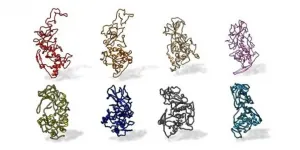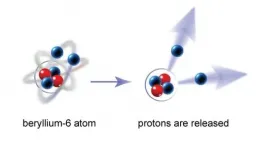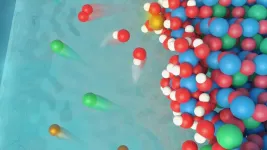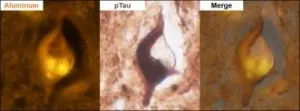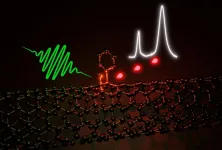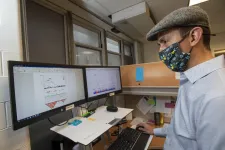Brain organoids uncover various mechanisms of virus-induced microcephaly
2021-04-09
(Press-News.org) Researchers at IMBA - Institute of Molecular Biotechnology of the Austrian Academy of Sciences - demonstrate that different viruses can lead to brain malformations through diverse mechanisms by using human brain organoid models. The results are published in the journal Cell Stem Cell.
Microcephaly, a term referring to developmental malformations of the fetal brain, can be caused by diverse infections during pregnancy. The infectious agents in question are grouped under the general term of TORCH pathogens, in reference to Toxoplasma gondii, Other, Rubella, Human Cytomegalovirus (HCMV), Herpes Simplex Viruses 1 and 2 (HSV-1 and HSV-2), as well as the more recently emerged Zika virus (ZIKV), which was also added to the group. The question whether all TORCH pathogens lead to microcephaly through the same mechanism has remained obscured due to the absence of suitable experimental models. Now, a team of researchers around IMBA Scientific Director Jürgen Knoblich provides the first comparative analysis of mechanisms linked to virus-induced microcephaly using a human brain organoid (HBO) model derived from human pluripotent stem cells (hPSCs).
"The two major difficulties in researching these conditions are, first, the delicate topic of testing noxious effects on fetal brain development during pregnancy which, understandably, prevents direct research on human fetuses, and second, the unsuitability of laboratory animal models, as they are neither the natural hosts of the viruses nor do they represent an accurate model of human brain development. To this end, our group was able to compare 3D human brain organoid models infected with different viruses. These infection models give us the closest possible insight into the human brain developmental outcomes of the viruses we study, and help us dissect the underlying structural, cellular, transcriptional and immunological parameters," explains first author Veronica Krenn, a postdoctoral researcher in the Knoblich group at IMBA. In the present study, the researchers are able to bypass these difficulties and gain precious insights on phenotypes reminiscent of microcephaly in organoids. Krenn and her colleagues do so by infecting 3D HBO cultures with TORCH viruses such as ZIKV and HSV-1 and demonstrate that both ZIKV and HSV-1 spread in organoids and halt their growth by promoting cell death. Through transcriptional profiling, the team shows a unique feature of HSV-1 infection in organoids, namely a propensity to impair their neuroepithelial identity. Another major finding is that, although both ZIKV and HSV-1 attenuate the Type I interferon (IFN) immune response system in organoids, they appear to do so through different mechanisms, as is made evident by rescue experiments using distinct Type I IFNs.
The findings highlight the distinct paths used by various TORCH viruses to cause microcephaly and reveal complex cellular immune defenses, such as a neuroprotective role of various Type I IFN responses. The importance of these findings also resides in their unique observation in 3D brain organoid cultures, and not in 2D culture systems, thus stressing the superiority of HBO models in reproducing virus-induced neuropathological conditions and their relevance in studying the mechanisms of viral infections.
Taken together, this new research from the Knoblich lab presents organoid infection models that could help test therapeutic agents against ZIKV and HSV-1 infections and better dissect the human interferon responses. "By specifically infecting organoids with viruses, we can not only learn a great deal about the critical brain development interactions that are typically complex in humans. We will also be able to better target weak points of these viruses to find possibilities for new therapies," summarizes IMBA Scientific Director Jürgen Knoblich, the corresponding author of the study.
INFORMATION:
This study was conducted in collaboration with researchers from Karolinska Institutet, Stockholm, Sweden, the National Veterinary Institute, Uppsala, Sweden, the Centre for Experimental and Clinical Infection Research, Hanover, Germany, the Hanover Medical School, Germany, the University of Padua, Italy, and the Federal University of Rio de Janeiro, Brazil.
Original publication:
Krenn et al., "Organoid modeling of Zika and Herpes Simplex Virus 1 infections reveals virus-specific responses leading to microcephaly", Cell Stem Cell 2021.
https://www.cell.com/cell-stem-cell/fulltext/S1934-5909(21)00110-7
About IMBA:
IMBA - Institute of Molecular Biotechnology - is one of the leading biomedical research institutes in Europe focusing on cutting-edge stem cell technologies, functional genomics, and RNA biology. IMBA is located at the Vienna BioCenter, the vibrant cluster of universities, research institutes and biotech companies in Austria. IMBA is a subsidiary of the Austrian Academy of Sciences, the leading national sponsor of non-university academic research. The stem cell and organoid research at IMBA is being funded by the Austrian Federal Ministry of Science and the City of Vienna.
[Attachments] See images for this press release:
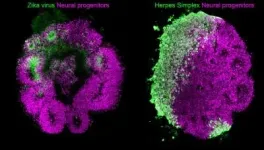
ELSE PRESS RELEASES FROM THIS DATE:
2021-04-09
Electrical batteries are increasingly crucial in a variety of applications, from integration of intermittent energy sources with demand, to unlocking carbon-free power for the transportation sector through electric vehicles (EVs), trains and ships, to a host of advanced electronics and robotic applications.
A key challenge however is that batteries degrade quickly with operating conditions. It is currently difficult to estimate battery health without interrupting the operation of the battery or without going through a lengthy procedure of charge-discharge that requires specialised ...
2021-04-09
Washington, DC (April 9, 2021) -- The American Society of Nephrology (ASN) and the National Kidney Foundation (NKF) announce the concurrent publication of "Special Article: Reassessing the Inclusion of Race in Diagnosing Kidney Diseases: An Interim Report from the NKF-ASN Task Force" in the Journal of the American Society of Nephrology (JASN) and the American Journal of Kidney Diseases (AJKD).
The publication in JASN and AJKD provides an essential review of the many challenges relative to identifying and implementing alternative methods to diagnosing kidney diseases. Last month, ASN and NKF asserted that race modifiers should not be included in equations used to estimate kidney function. ASN and ...
2021-04-09
A tiny protein of SARS-CoV-2, the coronavirus that gives rise to COVID-19, may have big implications for future treatments, according to a team of Penn State researchers.
Using a novel toolkit of approaches, the scientists uncovered the first full structure of the Nucleocapsid (N) protein and discovered how antibodies from COVID-19 patients interact with that protein. They also determined that the structure appears similar across many coronaviruses, including recent COVID-19 variants -- making it an ideal target for advanced treatments and vaccines. They reported their results in Nanoscale.
"We discovered new features about the N protein structure that could have large implications in antibody testing ...
2021-04-09
Since 2016, a federal regulation has allowed nurse practitioners and physician assistants to obtain a waiver to prescribe buprenorphine, a medication used to treat opioid use disorder as a medication assisted treatment.
But a recent study by Indiana University researchers found the bill, called the Comprehensive Addiction and Recovery Act (CARA), has not greatly increased the amount of nurse practitioners prescribing buprenorphine, especially in states that have further restrictions. The study was published in Medical Care Research and Review.
"Nurse practitioners and physician assistants are an important workforce with a capacity to expand treatment access for those with substance use disorders," said Kosali Simon, ...
2021-04-09
Michigan State University's Witold Nazarewicz has a simple way to describe the complex work he does at the Facility for Rare Isotope Beams (frib.msu.edu), or FRIB.
"I study theoretical nuclear physics," said Nazarewicz, John A. Hannah Distinguished Professor of Physics and chief scientist at FRIB. "Nuclear theorists want to know what makes the nucleus tick."
There is a nucleus in every atom. Atoms, in turn, make up matter -- the stuff we interact with every day. But the nucleus is still shrouded in mystery. One of FRIB's goals in creating rare isotopes, or different forms of elements, is to better understand what's going on inside the cores of atoms.
In a new paper for END ...
2021-04-09
Led by a South African team at the South African Medical Research Council Centre for Health Economics and Decision Science (PRICELESS-SA) in the School of Public Health at the University of the Witwatersrand, Johannesburg (Wits), and the University of the Western Cape, in partnership with the University of North Carolina, USA, the study was published on 8 April in The Lancet Planetary Health.
South Africa faces an increasing burden of non-communicable diseases (NCDs) such as diabetes, hypertension, cardiovascular disease and cancers - diseases that can be linked to increased consumption of sugar, particularly ...
2021-04-09
A clean energy future propelled by hydrogen fuel depends on figuring out how to reliably and efficiently split water. That's because, even though hydrogen is abundant, it must be derived from another substance that contains it -- and today, that substance is often methane gas. Scientists are seeking ways to isolate this energy-carrying element without using fossil fuels. That would pave the way for hydrogen-fueled cars, for example, that emit only water and warm air at the tailpipe.
Water, or H2O, unites hydrogen and oxygen. Hydrogen atoms in the form of molecular hydrogen must be separated out from this compound. That process depends on a key -- but often slow -- step: the oxygen evolution reaction (OER). The OER is what frees up molecular ...
2021-04-09
Amsterdam, April 9, 2021 -- This study builds upon two earlier published studies (Mold et al., 2020, Journal of Alzheimer's Disease Reports) from the same group. The new data, also published in the Journal of Alzheimer's Disease Reports, demonstrate that aluminum is co-located with phosphorylated tau protein, present as tangles within neurons in the brains of early-onset or familial Alzheimer's disease (AD). "The presence of these tangles is associated with neuronal cell death, and observations of aluminum in these tangles may highlight a role for aluminum in their formation," explained lead investigator Matthew John Mold, PhD, Birchall Centre, Lennard-Jones ...
2021-04-09
The properties of carbon-based nanomaterials can be altered and engineered through the deliberate introduction of certain structural "imperfections" or defects. The challenge, however, is to control the number and type of these defects. In the case of carbon nanotubes - microscopically small tubular compounds that emit light in the near-infrared - chemists and materials scientists at Heidelberg University led by Prof. Dr Jana Zaumseil have now demonstrated a new reaction pathway to enable such defect control. It results in specific optically active defects - so-called sp3 defects - which are more luminescent and can emit single photons, that is, particles of light. The efficient ...
2021-04-09
A new study using human genetics suggests researchers should prioritize clinical trials of drugs that target two proteins to manage COVID-19 in its early stages.
The findings appeared online in the journal Nature Medicine in March 2021.
Based on their analyses, the researchers are calling for prioritizing clinical trials of drugs targeting the proteins IFNAR2 and ACE2. The goal is to identify existing drugs, either FDA-approved or in clinical development for other conditions, that can be repurposed for the early management of COVID-19. Doing so, they say, will help keep people with the virus from being hospitalized.
IFNAR2 is the target ...
LAST 30 PRESS RELEASES:
[Press-News.org] Brain organoids uncover various mechanisms of virus-induced microcephaly

